Neither TV nor digital: the third option. Can OOH become the "next reach media"? ~Looking at "Japan's Advertising Expenditure 2024" from an OOH perspective~
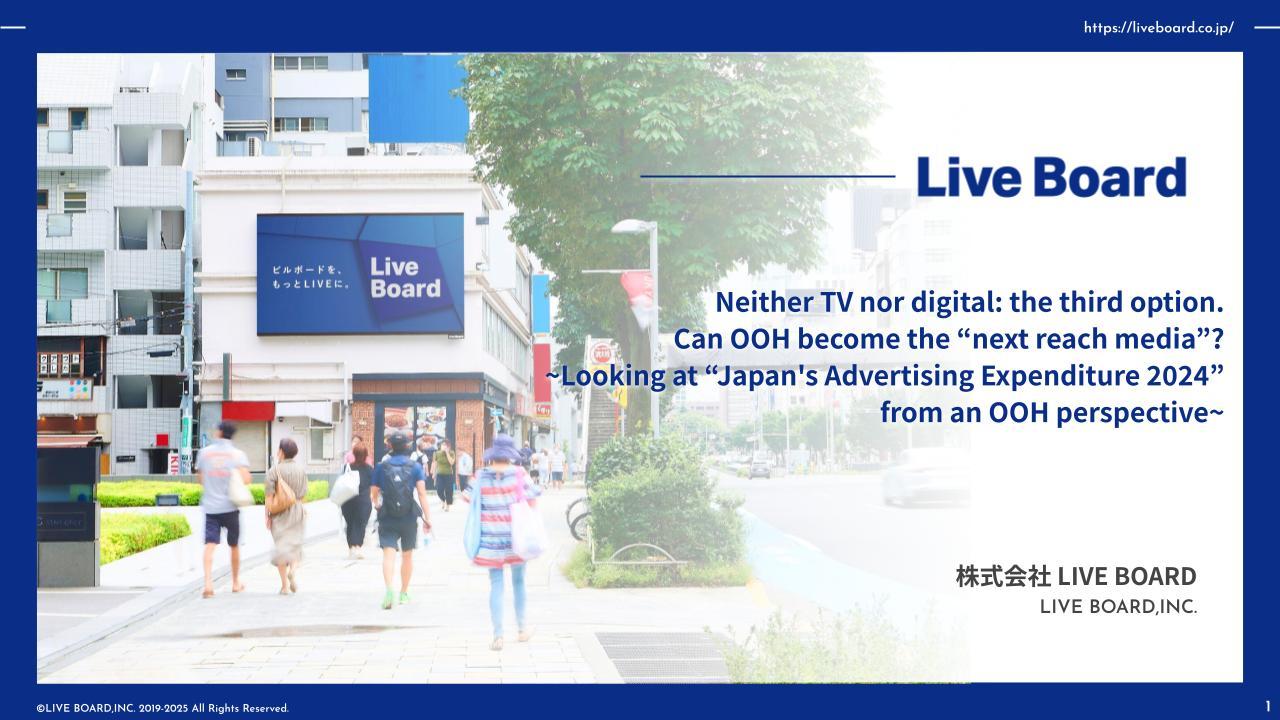
LIVE BOARD analyzed DENTSU INC.'s "2024 Advertising Expenditures in Japan" report, released in February 2025, from an OOH perspective.
■Advertising Expenses: Overall Summary
According to DENTSU INC.'s "2024 Advertising Expenditure in Japan," Japan's total advertising expenditure reached 7.673 trillion yen, setting a new record high for the third consecutive year. Internet advertising expenditure in particular grew by 109.6% year-on-year, driving overall growth.
On the other hand, advertising expenses for promotional media, including OOH, remained nearly flat at 101.0% year-on-year.
An analysis of promotional media advertising expenses over the past 10 years shows that there has been an overall downward trend since 2014. There was a temporary sharp increase in 2019, but this was due to high advertising demand related to the 2019 Rugby World Cup and the G20 summit held in Osaka, as well as the inclusion of "event advertising" in the calculation.
■Advertising expenses_OOH
First, LIVE BOARD was established in 2019, just prior to the coronavirus pandemic. Around this time, outdoor and transportation advertising began to shift to digital signage in earnest.
Furthermore, it can be seen that advertising spending for both outdoor and transportation advertising declined significantly in 2020 due to the spread of COVID-19.
Factors contributing to this include a significant decrease in the number of commuters and students due to the spread of remote work, as well as the rise of internet video advertising as a reach medium. In fact, internet video advertising expenditure in 2021 was 512.8 billion yen, a significant increase from 386.2 billion yen the previous year, indicating an acceleration in the shift from traditional offline advertising to online advertising.
Since 2021, both outdoor and transportation advertising have been recovering.
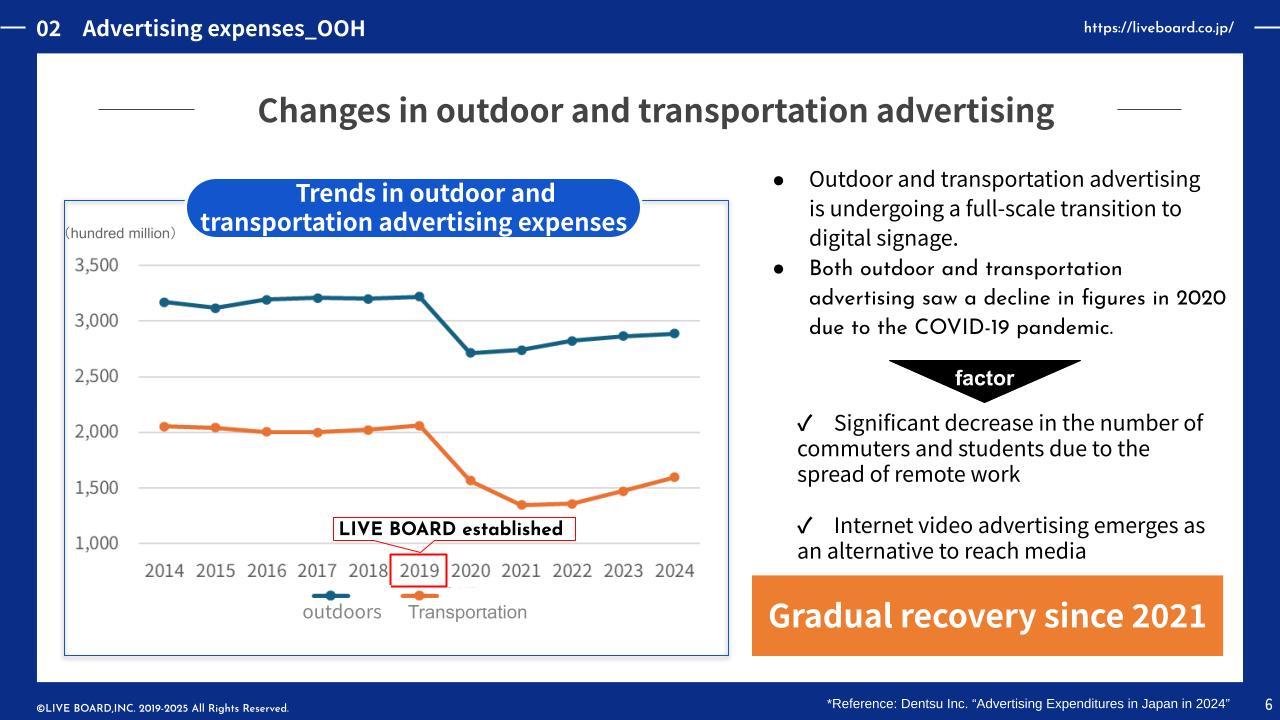
Following these changes in the environment and the advertising market as a whole, the presence of digital media has grown rapidly in recent years.
This trend is also evident in the OOH sector, where interest in the "digitization of OOH," or "DOOH (Digital Out of Home)," continues to rise. The DOOH market is projected to reach 93.4 billion yen in 2024, showing steady growth.
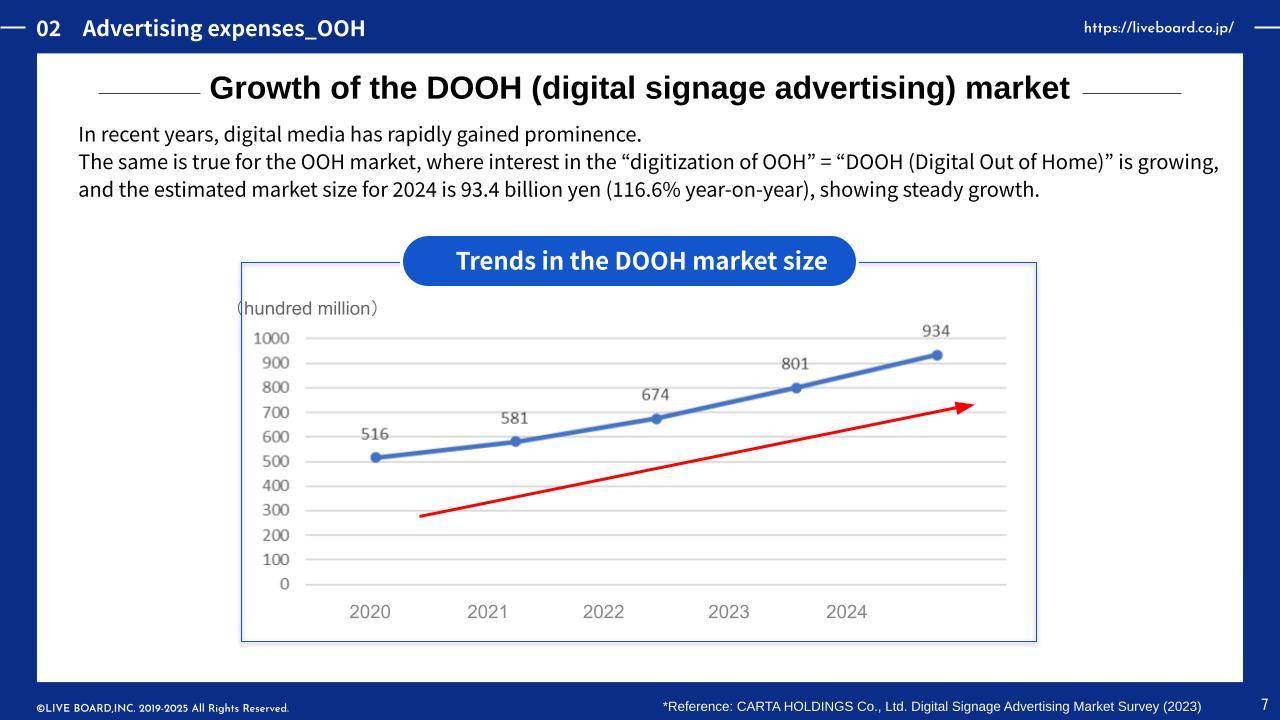
■Topics for 2024_Rapid growth of television digital media
2024 was a year in which digital advertising spending originating from mass media such as television, newspapers, magazines, and radio expanded significantly within the digital media sector. Communication originating from digital media is expanding beyond the boundaries of traditional media. In particular, TV-linked digital media ad spend grew at a remarkable 146.3% year-on-year, far outpacing other media.
Two major factors are behind this explosive growth:
The first is a shift in consumer viewing behavior. Television viewing behavior has shifted significantly from traditional terrestrial broadcasting to viewing via CTV (Connected TV) and streaming services. In fact, a survey by Video Research found that the amount of time spent watching videos using CTV increased by 533% compared to before the coronavirus pandemic.
The second factor lies with advertisers. In response to changes in consumers' lifestyles, the role of television advertising and the allocation of investment are being reviewed. According to a 2022 Intage survey, more than half of advertisers responded that they would "shift their budget from television to CTV advertising." This can be interpreted as an effort to compensate for the reach that television can no longer achieve by leveraging the same "television-like experience."
In addition, video advertising is experiencing remarkable growth in the Internet advertising market. The video advertising market valued at 686 billion yen in 2023, is projected to grow to 843.9 billion yen in 2024, a 123% year-on-year increase.
In this environment, the two leading reach media are now "television/digital television media" and "video (moving image) advertising." With television viewership expected to decline in the future, communication in the digital realm is likely to become increasingly important as a means of supplementing reach.
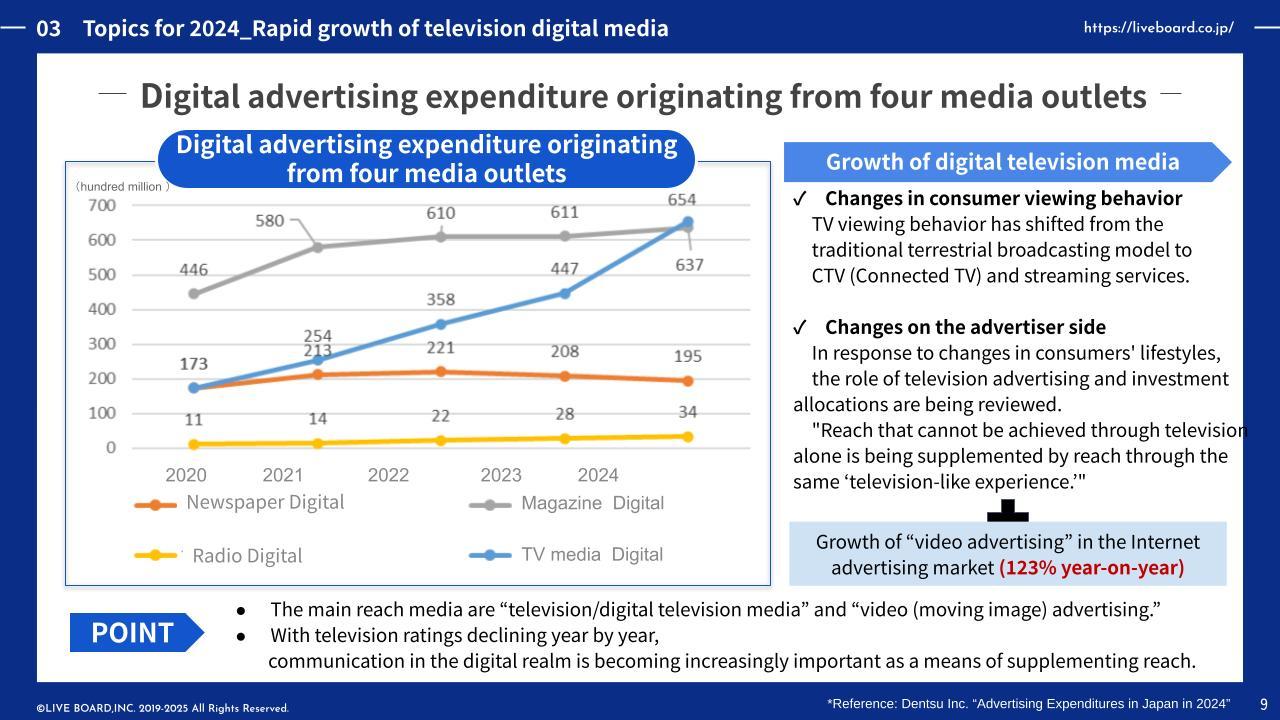
■Future Expectations and Prospects: Aiming for the Revival of OOH
In order for OOH to regain its presence as an advertising medium, it is important to establish its functionality as a reach medium and its position as a reach medium to television, whose viewership is declining. DOOH combines the unique strengths of OOH with the flexibility and measurability of digital media, enabling the creation of new value.
There are two major characteristics of OOH.
The first is diffusivity. As a medium that exists in public spaces, it is possible to reach many people at once.
The second feature is mandatory visibility. Unlike television, newspapers, magazines, and online media, which allow consumers to control whether to display or hide, read or not read, OOH advertising cannot be skipped or blocked.
These two features give OOH high potential in terms of reach and awareness.
However, at the same time, OOH still has several challenges to overcome in order to establish a solid position as a modern media.
The following three points are particularly important.
- Establishing a Standard Measurement System
Currently, there are no common metrics in the OOH market, and each company uses its own metrics to calculate advertising costs, making it difficult for advertisers to make decisions about placing ads. Discussions are already underway in Japan to establish measurement metrics for OOH. What is important is the design of metrics that are reliable and transparent, allowing advertisers to make decisions about placing ads with confidence. The introduction of unified metrics will enhance the overall reliability of the OOH market while also contributing to the expansion of advertising spending and the healthy growth of the industry. - Developing a PDCA Operational Model
Like TV and digital media, OOH must adopt a performance management system that allows evaluation across all campaign phases--planning, execution, and post-analysis. This is essential for its integration into broader media strategies. - Clarigying OOH's Unique Value
In order for OOH to be incorporated into media planning alongside television and digital media, it is necessary to clearly define what OOH can do that other media cannot. OOH is a medium that enables contact tailored to specific locations, times, and situations, and can create memorable "experiences" through real-life interactions. Furthermore, because it is a physical outdoor environment, it is possible to deliver advertisements with a strong impact. Efforts to visualize and evaluate these unique effects of OOH are crucial steps in broadly recognizing its value as a medium.
While these challenges exist, the market is already shifting its focus from "television or digital" frameworks to communication design based on the perspective of "which device to use and how to connect with it." In line with this trend, we too must redefine our role as "devices that exist in the real world outdoors," rather than being confined to the framework of "OOH," and rebuild a form of communication that is closely aligned with the actions and connections of consumers.
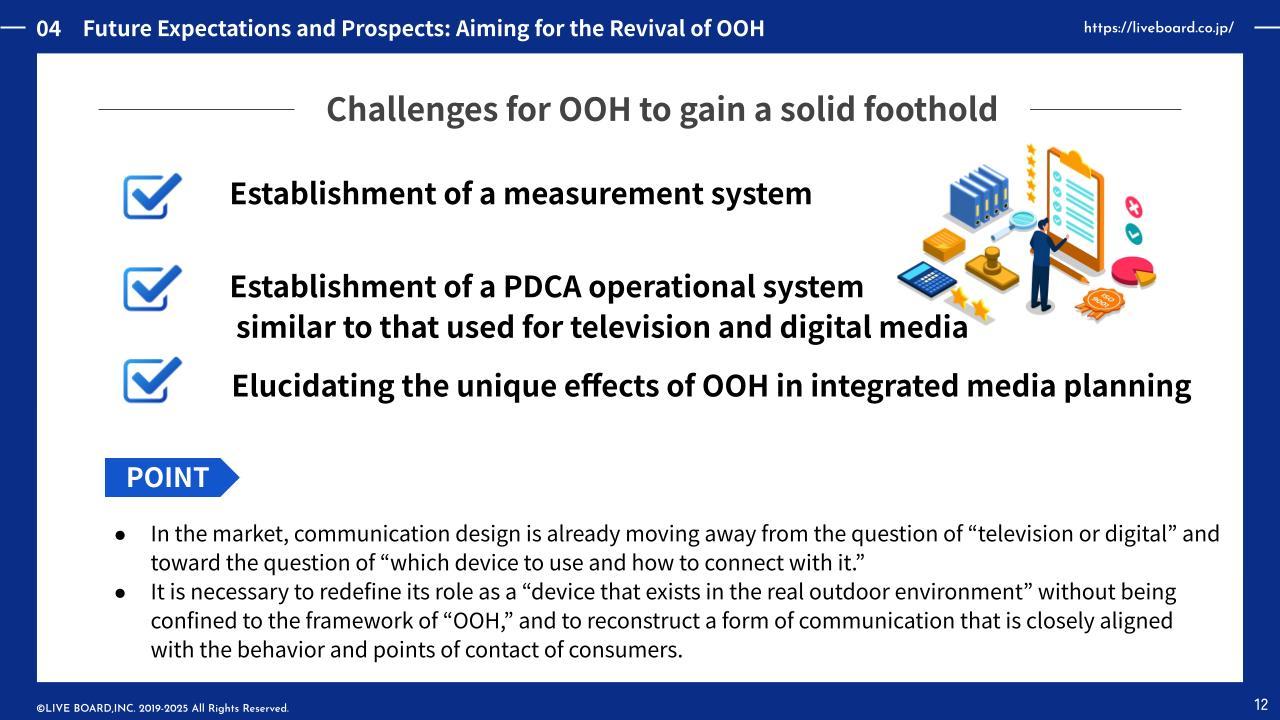
LIVE BOARD stands at the forefront of the evolution and redefinition of OOH, continuously updating the potential of OOH as a medium through the creation of value unique to OOH and the establishment of measurement foundations, operational systems, and integrated designs that support it.
